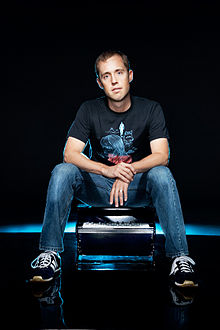- Color Theory
-
This article is about the musical alter ego of Brian Hazard; for the theory of color, see color theory
Color Theory 
Background information Genres Synthpop[1]
ElectronicaYears active 1993–present Labels 11th Records Website colortheory.com Members Brian Hazard Notable instruments piano, synthesizers Color Theory is the musical alter ego of American singer-keyboardist-songwriter Brian Hazard. Hazard has released eight studio albums, four EPs, and one collection of demos to date. His eighth studio album The Sound was released on August 4, 2010.
Contents
Biography
Hazard, the sole member of Color Theory, began studying the piano at the relatively late age of thirteen. He took lessons on and off through his high school years, while playing piano in the school jazz band and mallet percussion in the drumline. In 1992, Hazard was awarded a Bachelor of Music degree in Piano Performance from California State University, Long Beach. The following year he enrolled in songwriting and recording classes at Golden West College, and began writing songs for the first Color Theory album, Sketches in Grey.
Recordings
Sketches in Grey was a local success when it was released in 1994, quickly selling out the first pressing. But it wasn't until fledgling label A Different Drum included "Heart Like a Doll" on its first release, Rise! America's Synthpop Underground, that Color Theory was exposed to the small but dedicated modern synthpop scene.
Hazard began performing Color Theory material live after the release of 1997's Tuesday Song, which includes "The Perfect Song", first performed as a proposal to now-wife Michelle. Hazard long considered 1999's Perfect Tears his best work, representing the culmination of the "electronic piano pop" sound he'd worked six years to refine. 2001's Life's Fairytale explored mostly piano-less electronic textures, representing a significant change of course from earlier material. But the biggest change came with 2002's Something Beautiful, a fully acoustic recording featuring legendary drummer Jonathan Moffett, fretless bassist Baba Elefante, a string quartet, flute, harp, and Hazard on piano and vibraphone. Twenty-six weekly demo recordings were posted on the web as part of the “Bad Song of the Week” project, which allowed fans to vote for their favorites and decide which songs would ultimately be included on the album. These demos were released as a limited edition two-disc set entitled Like Clockwork.
2003 brought another sharp directional change with Color Theory presents Depeche Mode, a one-man tribute to Depeche Mode. In addition to eleven Depeche Mode covers and two new instrumental interludes, the album includes "Ponytail Girl", a Color Theory original that was mislabeled and widely circulated on file sharing networks as a Depeche Mode track from their yet to be released Exciter album.[2] Hazard's voice is said to resemble that of Martin Gore, which has confused Depeche fans.
Five years in the making, 2008's The Thought Chapter contains a Death Cab for Cutie cover and eleven new originals. “If It's My Time to Go” won both a Lennon Award[3] and the Grand Prize in the Electronic category[4] of the John Lennon Songwriting Contest. Judged by music industry veterans and recording artists such as Bob Weir, The Veronicas, and Al Jarreau, the Lennon contest is one of today’s most prestigious international songwriting competitions.[5] Hazard received over $8,500 in cash and musical equipment in connection with the awards, as well as free CD manufacturing for 2010’s The Sound. Color Theory’s eighth full-length album features nine new originals and a cover of “Living a Boy’s Adventure Tale” by synthpop legends a-ha.
Songs from The Thought Chapter and The Sound have been featured on the MTV shows Styl'd[6] and The Real World,[7] as well as the video game Rock Band.[8] The two albums also garnered Best Electronic nominations in the 2009 and 2010 OC Music Awards.[9][10]
Discography
Studio Albums
- Sketches in Grey (1994) - reissued (1999)
- Tuesday Song (1997)
- Perfect Tears (1999)
- Life's Fairytale (2001)
- Something Beautiful (2002)
- Color Theory presents Depeche Mode (2003)
- The Thought Chapter (2008)
- The Sound (2010)
EPs
- Covers & Rarities (2006)
- Second Thoughts (2009)
- The Silence (2010)
- The Silence + Second Thoughts (2011)
Notes
- ^ http://allmusic.com/artist/color-theory-p380827
- ^ "Color Theory presents Depeche Mode cover album". Side-Line. Sep 10, 2003. http://www.side-line.com/news_comments.php?id=152_0_2_0_c. Retrieved Jun 29, 2011.
- ^ "2008 Lennon Award Winners". John Lennon Songwriting Contest. http://www.jlsc.com/winners/2008b/lennon_awards.php.
- ^ "2008 Grand Prize Winners - Session II". John Lennon Songwriting Contest. http://www.jlsc.com/winners/2008b/winners.php.
- ^ "About the Contest". John Lennon Songwriting Contest. http://www.jlsc.com/about.php.
- ^ "Styl'd Ep. 103". MTV. http://www.mtv.com/shows/styld/episode.jhtml?episodeID=161233.
- ^ "Real World Las Vegas Ep. 2501". MTV. http://www.mtv.com/shows/real_world/lasvegas/episode.jhtml?episodeID=176637.
- ^ "Rock Band: Color Theory". Rock Band. http://www.rockband.com/songs/artists/Color+Theory.
- ^ "OC Music Awards recognize top local artists". Orange County Register. April 5, 2009. http://www.ocregister.com/entertainment/awards-79490-luke-award.html. Retrieved Jun 29, 2011.
- ^ "OC Music Awards Nominees Announced". OC Weekly. Feb 25, 2009. http://blogs.ocweekly.com/heardmentality/2009/02/oc_music_award_nominees_announ.php. Retrieved Jun 29, 2011.
External links
Categories:- Synthpop groups
- American electronic music groups
Wikimedia Foundation. 2010.
